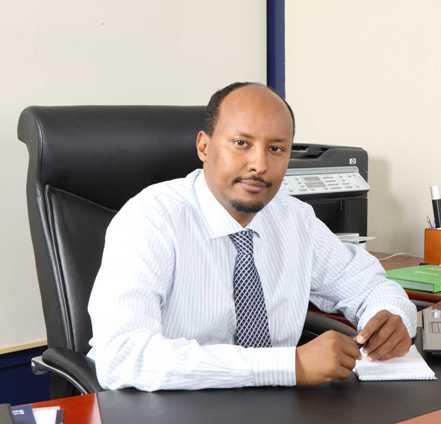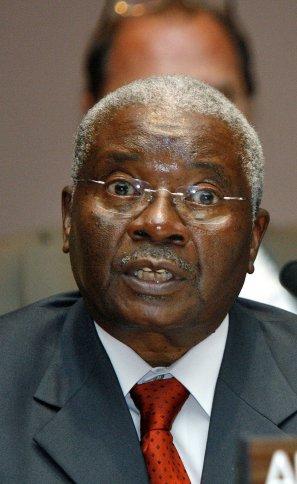Kenya: Saitoti’s death and the coming battle – By Richard Dowden

The death of George Saitoti in a helicopter crash on June 10th removes one of the most important players in Kenya’s piranha pool politics. Saitoti served as a senior minister in the presidencies of Daniel arap Moi and Mwai Kibaki for more than 30 years, but he was more of an executive prime minister than a political boss. Although he was planning to run for the presidency, his mixed parentage – Kikuyu and Masai – would never have given him unqualified support among the Kikuyu in Kenya’s highly tribalised politics, while the Masai are not numerous enough to be big political players. Although Kenya’s professional classes may have voted for Saitoti, he was not a populist speaker and would have stood no chance against Uhuru Kenyatta for the Kikuyu vote. According to Charles Hornsby author of Kenya: a History Since Independence, “Saitoti was simply too reserved, distant, academic, and non-tribal – and he didn’t have the common touch.”
A maths lecturer at Nairobi University who also wrote an influential book on development, he was invited by President Moi to become Finance Minister in 1983. The end of the Cold War in the late 1990s meant that Britain and other western donors could force multi party democracy on Kenya and also move the economy from a highly regulated state managed model to a free market. Structural Adjustment accelerated that process but without the aid needed to support the transition. It was introduced at the same time as the one party state gave way to a multi-party democracy. Ironically, Kenya (the African nation most favoured by the West) was one of the last to introduce a multiparty system. Saitoti was a central figure in implementing both of these fundamental changes.
Multi party democracy meant competition and that meant Harambees to get the Wananchi to vote for the ruling party. Harambees are open air rallies at which the Wananchi – the ordinary people – are persuaded by the Big Men to vote for them. This means Nyama Choma (roasted meat), drink and wads of cash for the people.
But how was KANU, the Kenya African National Union, ruling party since independence, to raise money for Nyama Choma? The answer was Goldenberg – an export promotion scheme whereby anyone who exported gold or diamonds could claim 35 percent of their value as a state subsidy. The joke was that Kenya has very little gold and no diamonds.
Payment for the scheme came under the consolidated fund and therefore did not need parliamentary approval. But it did have to be signed off and Saitoti, as Minister of Finance, did just that. He even extended it. Whilst he may not have actually constructed Goldenberg, Saitoti implemented it, and almost certainly benefitted from it personally.
Some £2 billion were stolen from the Kenyan state. Most of the money went to individuals, Kamlesh Pattni who founded Goldenberg International, and Gideon Moi, President Daniel arap Moi’s son. In all 487 companies, many set up just for the purpose, collected money from the scam. It was the moment when corruption in Kenya became the norm in big businesses and the upper echelons of state affairs. It was a moment when the corruption tick became almost bigger than the state dog it fed on.
In a subsequent inquiry, Saitoti and Pattni were named as culprits and Pattni was detained for a while. Then the whole affair was quietly dropped. The election had been won, and some of Kenya’s richest politicians, including Moi himself, were now multi-millionaires. No money was returned. Later, some 23 senior judges were forced to resign as a result of their involvement in the scandal. In a strange way the Kenyan state survived.
Throughout all of this Saitoti, as well as other senior Kenyan politicians involved in the scam, were welcomed to London. This was despite a former head of the Africa department of MI6 heading a forensic investigation into where the Goldenberg money had gone. To the British and US governments the strategic and economic importance of Kenya trumped corruption.
Kenya’s senior politicians became so wealthy that politics became a game based on “˜eating’ and “˜feeding’ – stealing and spreading the proceeds around an ethnic support base in return for votes. Appealing to and buying tribal loyalty became the name of the game. Kenya is probably now the most tribally divided nation in Africa. No wonder the 2007 election exploded into such violence.
Will it happen again?
With two tribalist leaders, Uhuru Kenyaata and William Ruto, facing a trial at The Hague which may start in March next year (the exact date will be announced on July 13th), the Kenyan election is wide open. Victory will go to the person who builds an alliance of tribal leaders. One thing is certain: Luo and Kikuyu will be on opposite sides. Raila Odinga, the Luo leader, will run and elements among the Kikuyu will do anything to stop him becoming president. For a while I thought that in 2008 Kenyans had reached the edge of the cliff and looked down. They wavered and pulled back. The militants were called off by their paymasters. Kofi Annan was on hand to help. Kenyans had seen a future that looked like hell and chose a fudged alliance of enemies instead.
That alliance is now falling apart. The new constitution has recreated a Kenya of 47 counties, whose elected governments will be funded by the state to spend as they wish. It is, however, likely that a local politician from the dominant ethnic group in each county will be playing the ethnic card to garner support.
In 2008 the main wars were in Nyanza Province (Luoland) where (Kikuyu) police shot down Luo protesters, around Eldoret where Kikuyu immigrants were burned out of their homes and murdered by Kalenjin, and in Nairobi where battles took place in the poor slum areas between different ethnic groups. If politicians play the ethnic card in the next election, this winner-takes-all war could be fought in most of the new counties between any or all of Kenya’s 40-odd ethnic groups.
Richard Dowden is Director of the Royal African Society and author of Africa; altered states, ordinary miracles. For more of Richard’s blogs click here








Hi Richard,
I like your article but being that am a Kenyan by birth i have more information than you, you seem to be having fact right, but i can give you more insights into what has caused all the tribalism in Kenyan and the people who play tribal cards to gain whenever we are having an election.
So sad the poor Kenyan irrespective of which tribe they come from will alway take sides Not knowing they are being used.
get in touch and we can talk more.
Regards,
Evans,
So many mistakes. Saitoti is not of mixed parentage. He is a full Kikuyu born in Gikambura and migrated to Masai area as a young lad. His official name till 1983 was George Kiarie Muthengi. Secondly, harambees are fund raising rallies where wanainchi give money for development projects. Usually there is no feast
Many mistakes but one stands out. During the post election violence it wasn’t the Kikuyu police killing the Luos in Kisumu and if you get the case in court the police man facing charges is a Kalenji. Unlessas a journalist you have proof of which policemen they were, with names to affirm the tribe then one cannot write such a gross missleading statement. The police force recruits Nationaly.
Kenyans have allergy to truth and a penchant for attacking plain speakers. Rather than learn a great deal from this courageous author and reflect on the sad realities noted herein, I expect zealots to “shoot the messenger” of course in the spirit on “patriotism” and the refrain Kenya is sovereign so leave us alone!
Good try but hard to take your article seriously.
Musimbi, you are also wrong. Saitoti was given a Maasai name in the early 60s when he was leaving for further studies abroad. The late Reverend Christopher Rapasi, the next door neighbor, is said to have suggested the name. But it’s also interesting since he was educated at PCEA Oloolua church (considered the “Home Guard church”) as opposed to Catholic church which was more pro-liberation.
The reason he was given the name is because the Gikuyu who had been forcefully moved to Ngong mainly from Masailand where they had run away to escape persecution after the the declaration of emergency, were viewed as either Mau Mau or their sympathizers. Please get your facts right.
Richard, I have always admired your articles and even your book, Africa: Altered States,Ordinary Miracles. However, In this article, you needed to do some research before making public such level of inaccuracy. They are many but allow me to point out three.
Firstly, you need to play Harambee spirit in Kenyan context. Reducing it to Nyama Choma and vote hunting phenomenon is too simplistic and a display of limited capacity to analyse Kenyan politics. Secondly, you seem to link the purge in the judiciary with Goldenberg Scandal. It is true that some of them were removed due to corruption, but it had little to do with their role in Goldenberg. Thirdly, Yes, tribalism or negative ethnicity is rife in Kenya. But your analysis of Luo-Kikuyu divide assumes that they are not communities with millions of socially, economically and politically independent individuals. You reduce them to two people, who in electoral contest, will only have two choices.
Please research before writing
Liz,
Correction, the author is right. If you want to get the truth on this statement as those from Migori about a certain police women who was killing even children. And for your information, the kalenjin who was said to have shot a man in Kisumu was not found guilty as the bullet that killed the man was not from his gun. Get the facts right.
Good article.
Kudos!Richard Dowden,don’t worry the comments!Kenyans hate the Truth…your article is superb.Tribalism brought Kenya to it’s knees in 20007/2008 so I don’t know why respondents like Liz are trying to be so defensive of a particular tribe.Nangaya Musimbi,stop misleading Us,we are all Kenyans and we all know some fundraisers are political and people are even bribed for votes in this functions that is why Fundraising activities have been banned 6 Months to the election in the new constitution.So what if Saitoti was Kikuyu or Maasai,what are those arguing about his ethnicity here trying to justify?So sad,how tribal Kenyans can be it is terribly disturbing!Again Richard,kudos for your insight in this article.Keep them coming!
Great article outlining how we Kenyans can be tribal. It is for a fact that people fight for what they do not know. One is in the slums, fights for some big fish out there who brainwashes their minds and at the end of the day remains in the slums with even worse conditions, for what???????? It is about time that every individual makes decisions without any influence. Goes back to what the bible says “My people are destroyed for lack of knowledge, Hosea 6:6” and Proverbs 10:21 The lips of the righteous nourish many, but fools die for lack of judgment.
So instead of being negative towards the article, it is about time that we start using brains and judge what we are fed with before it becomes our own enermy and eat us from the inside.
Still remember one “crisis” afternoon when my angry boss dragged me (in his official limousine) to the Treasury Building: “to be reprimanded for delaying the VP’s project”.
It was the first time for this humble civil servant to come into this building via the VIP parking garage — first time to ride in the VIP elevator and first time to be saluted by a plethora of bodyguards. The irony of these “firsts” was completely lost on my “heavyweight” boss.
The first person that we bumped into — inside the VP’s office — was the late Honourable Elijah Mwangale (Minister of Agriculture) who smiled broadly in my direction……..the first shock for my boss.
Then came Professor George Saitoti from his inner sanctum with an urgent: WHERE IS THIS LAWYER FROM SHERIA HOUSE…….I HAVE BEEN WAITING ALL MORNING TO SIGN THIS CONTRACT”. My boss advanced importantly to wash his hands from my guilt.
But the Professor had already recognised my now quite scared mug-shot and observed: “WHY DID THEY NOT TELL ME THAT IS IS YOU MARINGA — THEN I COULD HAVE DONE SOMETHING ELSE — UNTIL YOU ARE READY FOR THE SIGNATURE.”
Mheshimiwa Sir (answered me quietly) here is the document ready for your signature. OKAY THEN LEAD US TO THE BOARDROOM FOR THE OFFICIAL CEREMONY.
Yes – that was me at the Press/TV briefing for that day — smiling broadly next to my now totally bewildered boss.
Goodbye PROFESSOR SIR — and thanks again for your implicit trust and support of the “watumishi wadogo” like me !!!!!
Richard,
I enjoyed the article but I wanted to point out four main inaccuracies:
1. Prof. George Saitoti is not of mixed parentage (Maasai & Kikuyu).
Contrary to that, Prof. Saitoti was born in Kiambu, Kenya of Kikuyu parents. His birth name was George Kinuthia Kiarie. In the colonial era (Pre 1963) when villages gicagis were created to confine the Kikuyu, Saitoti’s parents moved to maasailand and he changed his name while at Mang’u High School in order to obtain a scholarship to Cambridge School, Weston. Note that even today, parents register their kids to sit national exams in remote parts of Kenya so as to better position them for admission to a “National Schoolâ€. National Schools admit students by merit and apply a quota system to admit students from certain parts of the country like northern Kenya. Therefore, Saitoti stood a better chance of obtaining a scholarship if he changed his last name from the Kikuyu- Kiarie to Saitoti. His brothers still bear kikuyu names and they identify themselves as Kikuyu. Note also that Saitoti was challenged in the Maa language and always used an interpreter in large gatherings in maasailand. It is true though that he was widely accepted by the maasai as one of them and he did live a life that rose above tribal politics. However, the fact is that he was a Kikuyu.
2. “Harambees are open air rallies at which the Wananchi – the ordinary people – are persuaded by the Big Men to vote for them.â€
The term Harambee was coined by Mzee Jomo Kenyatta, Kenya’s first President. It means “pulling together.†Harambees are essentially fundraising drives,Pulling funds together for projects e.g. university tuition, church projects etc. Harambees in which the guest of honor is a politician usually turn into political rallies. However, open air rallies during the election season in which cash is distributed to councilors and locals are just that- political rallies. Generally, they are referred to as political rallies and not Harambees. Note that everything you said in reference to Harambees is true except for what appears to be the definition.
3. “(Kikuyu) police shot down Luo protestersâ€
This is not accurate. Police shot down Luo protestors. At the beginning of the post election fracas, on day one, the police in Kisumu was a mixed regiment. Police had an order to shoot. They shot at civilians indiscriminately. If you look at the culture of the police in Kenya, they have been known to shoot at civilians, in Nairobi and in other parts of the country.
4. “around Eldoret where Kikuyu immigrants were burned out of their homes and murdered by Kalenjin,â€
We do not consider the residents of an area who are from another ethnic group to be “immigrantsâ€. Kikuyus have lived across the country, just like other ethnic groups have, since the colonial “emergency†pre-colonial era. Their economic dominance and the issue of land ownership among other social factors have been a bone of contention. However, they are not considered “immigrantsâ€. A better term would be “settlersâ€, because they were moved from their ancestral home in Central Province by the colonial government and settled in gicagis in the rift valley for political reasons.